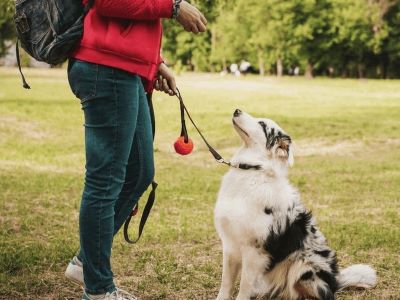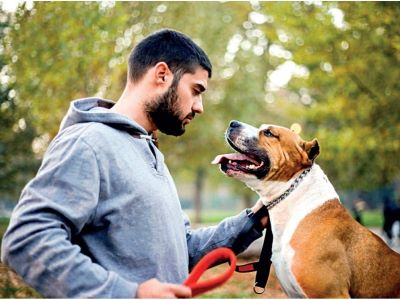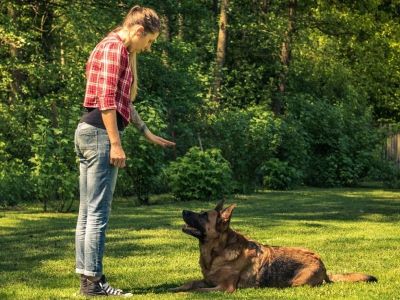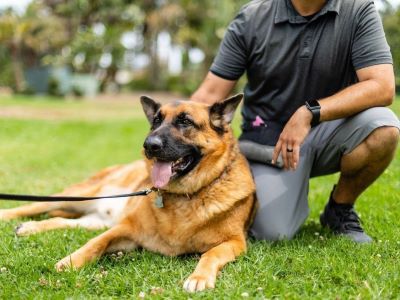A world where dogs are taught to obey through strict rules and even punishments. It’s a bit like a strict teacher in school but for dogs. So, what exactly is compulsion dog training? and what drives people to use it when there are gentler alternatives.

Let’s understand the enigmas behind compulsion training and understand why it’s still in practice today.
What Is Compulsion Dog Training?
Compulsion dog training is an age-old method rooted in discipline and control. It teaches dogs to follow commands through corrections and sometimes punishments.
This approach is commonly used in situations where strict obedience is crucial, like with working dogs, police or military canines, and in competitive dog sports. Trainers use aversive techniques, like leash corrections and special collars (e. g., choke or prong collars), to correct undesirable behaviours.
The idea is to make dogs associate their actions with negative consequences to discourage those actions in the future. Compulsion training can work with strong-willed dogs like German Shepherds or Rottweilers but may make sensitive dogs anxious.
It’s essential to consider a dog’s individual personality when choosing a training method. Many responsible trainers now favour positive reinforcement techniques, using treats and praise to encourage good behaviour.

Note: Compulsion training does not involve harming or abusing dogs. It may require physical restraint or correction in some cases to encourage obedience. However, it's important to keep in mind that each dog has a unique personality.
Principles of Compulsion Dog Training
Compulsion dog training employs a set of fundamental principles to shape a dog’s behaviour effectively. Let’s see some of these principles:
1. Positive Reinforcement
In compulsion training, positive reinforcement is a big deal. This means when a dog does what it’s supposed to do, it gets rewarded.
Rewards can be praise, treats, or cuddles. These rewards encourage the dog to keep doing the right thing[1].
2. Negative Reinforcement
In compulsion training, there’s something called negative reinforcement that’s important. This means that when a dog does what it’s told, something uncomfortable or annoying stops[2].
For example, if a dog is learning not to pull on a leash, the pressure on the leash goes away when the dog walks nicely. This removal of discomfort encourages the dog to keep behaving well.
Compulsion training really focuses on this idea of making dogs avoid discomfort by following commands quickly, which motivates them to behave correctly.

3. Positive Punishment
Compulsion training uses positive punishment to discourage unwanted behaviour. This means when a dog does something undesirable, it might receive a scolding or a physical correction to make it not want to do that thing again.
For instance, if a dog jumps on people, it might get told off or gently corrected to stop it from jumping in the future.
4. Negative Punishment
On the flip side, in compulsion training, there’s something called negative punishment. This means that when a dog does something wrong, it loses something nice.
For example, if a dog jumps on someone, and that person ignores the dog, it’s a way of taking away the attention the dog wants. This helps the dog understand not to repeat the bad behaviour.
Compulsion dog training is a method that uses corrections to deal with bad dog behaviours. It might include physically putting dogs in the right positions, correcting them with the leash when they make mistakes, and praising them when they do things right.
Methods and Techniques
Compulsion dog training employs various methods and techniques to shape a dog’s behaviour. Let’s explore some of these methods in more detail:
Collars
These are electronic collars that can deliver an electric shock to the dog when triggered. They are used to correct unwanted behaviour by causing discomfort. Choke chains are metal collars that tighten around a dog’s neck when pulled.
They are designed to discourage pulling or disobedience by causing discomfort. Prong collars have metal prongs that poke into the dog’s neck when tension is applied. They are used to correct behaviour through discomfort.

Corrections
Leash corrections involve using the leash to apply pressure or give a quick jerk when the dog misbehaves or disobeys a command. This is meant to discourage unwanted behaviour.
Verbal corrections are stern commands or reprimands used to correct a dog’s behaviour. These verbal cues convey disapproval and are intended to discourage undesirable actions.
In today's time, there is a growing trend towards positive reinforcement-based methods that focus on rewarding good behaviour with treats and praise. These approaches foster a stronger bond between dogs and their owners and create a more enjoyable learning experience for both parties
Responsible Compulsion Training
While compulsion training can be a subject of debate, there are responsible practices that focus on the dog’s well-being. Find a trainer skilled in compulsion techniques who also understands dog behaviour.
- Look for qualifications, certifications, and a positive reputation. Ensure the trainer knows various training methods, including positive reinforcement, and knows when to choose gentler approaches.
- If compulsion training is necessary, make sure equipment like choke chains or shock collars is used with care. Adjust collars correctly to reduce discomfort and risk of injury.
- Use shock collars at the lowest settings to prevent undue pain or distress. Always prioritise the dog’s comfort and well-being when using these tools.
- Responsible compulsion training means keeping an eye on your dog’s stress and anxiety during training sessions. Recognize signs of stress, like panting or trembling, and adapt your training accordingly.
Give your dog regular breaks to relax during sessions. If your dog consistently seems stressed, reconsider the training approach and explore gentler methods.
Pros and Cons
Let’s see the pros and cons of compulsion dog training:
| Pros | Cons |
|---|---|
| – Quick results | – Potential harm to the dog physically and mentally |
| – More control over the dog’s behavior | – Risk of creating fear, anxiety and aggression in the dog |
| – Strained bond between dog and owner |

Alternatives to Compulsion Dog Training
There are several alternatives to compulsion dog training that may be more effective. Here are some of them:
- Positive Reinforcement Training: This method focuses on rewarding good behaviour with treats, toys, and praise to encourage dogs to repeat desirable actions. It’s popular, effective, and enhances the bond between dogs and their owners.
- Clicker Training: Clicker training is a type of positive reinforcement that uses a small clicker device to signal to the dog when it has done something right. It’s great for teaching new behaviours and improving obedience.
- Science-Based Approaches: These methods are grounded in scientific research and principles of animal behaviour. They use positive and negative reinforcement to teach new behaviours and improve obedience. They’re humane and adaptable to individual dog needs.
- Relationship-Centered Training: This method prioritises building a strong bond between the dog and its owner. It involves understanding the dog’s personality, needs, and preferences and using positive reinforcement to encourage good behaviours.
These alternatives focus on understanding the dog and strengthening the human-dog relationship, making them more effective and compassionate ways to train and interact with dogs.
FAQs
What Are the Types of Dog Training?
Every celebrity dog trainer and pet manual seems to advocate a different style for teaching your pup. Though it seems confusing at first, they all boil down to three main techniques: the traditional dominance method, the scientific method and the positive reinforcement method.
What Is Compulsion Dog Training?
Traditional compulsion-based training works on the philosophy that we have to show the dog who is boss. She must do what we say, and quickly. If she doesn’t, we immediately correct her or she will learn that she can ignore our commands.
Is Dog Training a Skill?
A competent dog trainer must also have expertise in training people to learn the best methods for making a dog understand and obey their commands. Becoming a dog trainer therefore requires teaching skills in addition to expertise in working with animals.
Conclusion
In conclusion, “What is compulsion dog training?” compulsion training is an old method aiming for obedience through discipline and rules. It can work quickly but has debates and concerns.
There’s an ongoing debate about its effectiveness. Some say it’s good for certain jobs, but others worry it can harm dogs or hurt the bond we share with them.
However, there’s hope for better, kinder methods. Let’s keep choosing methods that make our dogs happy and healthy as we continue our journey together.
Reference:
- Positive reinforcement training. (n.d.-d). The Humane Society of the United States- THS
- De Castro, A. C. V., Fuchs, D., Morello, G. M., Pastur, S., De Sousa, L., & Olsson, I. a. S. (2020). Does the training method matter? Evidence for the negative impact of aversive-based methods on companion dog welfare- NIH



